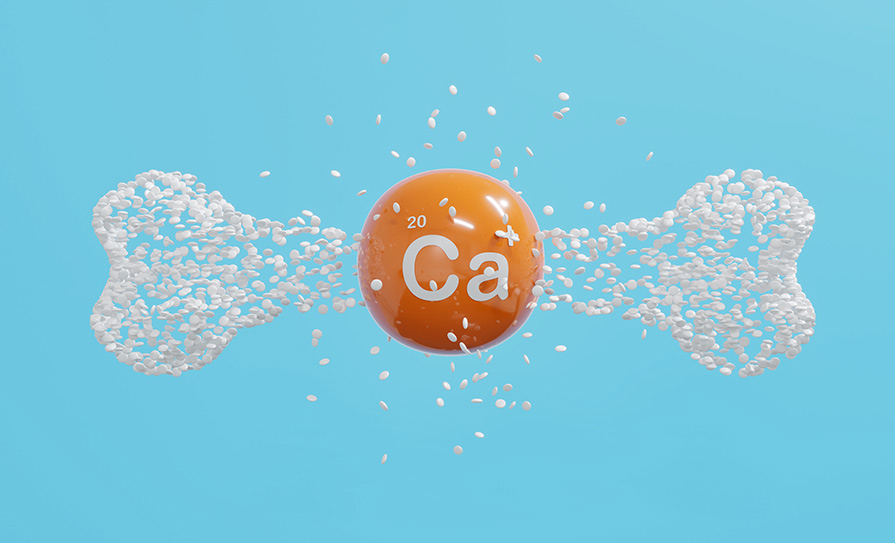
The death of my chemistry teacher caused me to ruminate on the complexities of calcium
The recent death of my kindly chemistry teacher nicknamed Sticky rekindled memories of 1960s schooldays in his lab: A chunk of potassium fizzing across the surface of a water bath; jars of vividly coloured powders; and… Sticky’s chalky right forearm.
At home, Mammy, busy with scallions for the champ, listened while I cleared my throat and divulged that “Chalk’s calcium carbonate, ya know.” Her reply, “Yes, that’s what I take,” astounded me. “You eat calcium carbonate?” Mammy, chopping scallions and disinclined to elaborate, was succinct: “Calcium somethin’ for bones. Now get changed.” Looking back, I guess Mammy was prescribed a supplement of calcium somethin’ for osteoporosis, a word I learned when I was long out of short trousers. Our GP Dr Magill had tonnes of books on his surgery’s shelves, so he wouldn’t have given Mammy calcium somethin’ without looking it up.
But time brings perspective, and if the truth of the relationship between calcium and osteoporosis is to be learned it will come long after the earth has absorbed the bones of Mammy and Dr Magill and Sticky, because unlike mineral sediments medical science is seldom settled. For example, in addressing ‘Calcium supplements controversy in osteoporosis…’, published in Endocrine (2015, 48: 776), Paziana and Pazianas attempt to show that calcium supplementation may not compensate for renal calcium loss, suggesting “that the resultant increased calcium load in the circulation could lead to extraskeletal deposition, including in the coronary arteries”. And in their consideration of ‘The good, the bad, and the ugly of calcium supplementation: A review of calcium intake on human health’, Li et al note in Clinical Interventions in Aging (2018,13: 2443–2452) how remarkable it is “that the effects of cardiovascular diseases between dietary and supplements of calcium lead to disparate results”, citing a study which indicated that the risk of myocardial infarction increased by taking calcium supplements compared with those who took no supplements. This finding, they suggest, is hardly surprising given that calcium supplements potentially contribute to raised concentrations of serum calcium, possibly accelerating cardiovascular calcification in the long run, which can predict cardiovascular events.
So, while Dr Magill’s advice to Mammy may have reflected the prevailing wisdom at the time, one might reasonably infer that the full-fat dairy-enriched diet we enjoyed back then might have obviated the need for calcium somethin’ tablets. This impression is strengthened by the findings of Iuliano et al who investigated the ‘Effect of dietary sources of calcium and protein on hip fractures and falls in older adults in residential care…’ and concluded in the British Medical Journal (2021;375: n2364) that consuming dairy foods to improve residents’ calcium and protein intakes reduced the risks of falls and fractures that commonly occur in this cohort.
Among the pressing issues affecting Belfast in the late 1960s early 1970s, the merits of a plant-based diet prompted limited debate; certainly not at our local butcher’s shop in whose lard we fried our bacon and eggs. Things have changed in Belfast, and while certain organisations are now proscribed, lard is not (yet). But despite the reservations of, for example, Zagmutt et al, who explain in The Lancet (2019, 394: 1140) that the EAT-Lancet report’s recommended diet “is based on a mis-specified modelling approach that might at best overpromise on the mortalities avoided, and at worst promote a solution favouring high-income countries that does not address the pressing issues of maternal and child malnutrition”, the enthusiasm in some quarters for plant-based diets appears refractory to evidence that questions such an approach. In this context it is perhaps worth considering Zheng et al, who write on ‘The hidden dangers of plant-based diets affecting bone health…’ (2023, 15: 1794), adducing evidence “that adherence to a plant-based dietary pattern is associated with decreased bone mineral density in a nationally representative population of US adults…”.
With Greenland et al noting in the Journal of the American College of Cardiology (2018, 72: 434) that coronary artery calcium (CAC) “has emerged as the most predictive single cardiovascular risk marker in asymptomatic persons, capable of adding predictive information beyond the traditional cardiovascular risk factors…”, it is intriguing to learn that when Sandesera et al, in Atherosclerosis (2020, 292: 224), investigated the clinical significance of zero CAC among those with LDL cholesterol ≥190mg/dL, they found that younger age, female sex, and the absence of diabetes were associated with CAC = 0, observing that CAC “is able to identify persons in this high-risk group who possibly will not benefit from aggressive LDL-C reduction”. This invites the inference that assertions like “high LDL concentrations cause cardiovascular disease” are inaccurate.
Calcium somethin’ plays more of a complex role in our lives than Mammy, Dr Magill, and Sticky anticipated.





Leave a Reply
You must be logged in to post a comment.